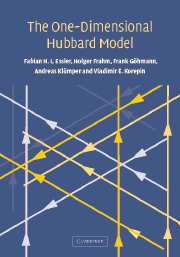Book contents
- Frontmatter
- Contents
- Preface
- 1 Introduction
- 2 The Hubbard Hamiltonian and its symmetries
- 3 The Bethe ansatz solution
- 4 String hypothesis
- 5 Thermodynamics in the Yang-Yang approach
- 6 Ground state properties in the thermodynamic limit
- 7 Excited states at zero temperature
- 8 Finite size corrections at zero temperature
- 9 Asymptotics of correlation functions
- 10 Scaling and continuum limits at half-filling
- 11 Universal correlations at low density
- 12 The algebraic approach to the Hubbard model
- 13 The path integral approach to thermodynamics
- 14 The Yangian symmetry of the Hubbard model
- 15 S-matrix and Yangian symmetry in the infinite interval limit
- 16 Hubbard model in the attractive case
- 17 Mathematical appendices
- References
- Index
11 - Universal correlations at low density
Published online by Cambridge University Press: 19 August 2009
- Frontmatter
- Contents
- Preface
- 1 Introduction
- 2 The Hubbard Hamiltonian and its symmetries
- 3 The Bethe ansatz solution
- 4 String hypothesis
- 5 Thermodynamics in the Yang-Yang approach
- 6 Ground state properties in the thermodynamic limit
- 7 Excited states at zero temperature
- 8 Finite size corrections at zero temperature
- 9 Asymptotics of correlation functions
- 10 Scaling and continuum limits at half-filling
- 11 Universal correlations at low density
- 12 The algebraic approach to the Hubbard model
- 13 The path integral approach to thermodynamics
- 14 The Yangian symmetry of the Hubbard model
- 15 S-matrix and Yangian symmetry in the infinite interval limit
- 16 Hubbard model in the attractive case
- 17 Mathematical appendices
- References
- Index
Summary
In Chapter 9 we developed the picture of the asymptotics of the correlation functions of the Hubbard model for the phases with gapless excitations, i.e., for the phases with ground states belonging to regions II and IV of the ground state phase diagram discussed in Chapter 6.3 (see figures 6.4, 6.5). Our results relied on the predictions of conformal field theory which are expected to hold for a whole universality class of models related to the Hubbard model and which only need the finite size data calculated in Chapter 8 as input parameters. Correlation functions at half-filling (phase V) were considered in the previous chapter on the basis of a special continuum limit and the predictions of certain integrable quantum field theories.
Here we shall consider correlation functions in the phase whose ground state is the empty band (phase I in the ground state phase diagram, figures 6.4, 6.5). At zero temperature the boundary of this phase in the μ-B plane (see figure 6.5) is determined by equation (6.20): μ < μ0(B). For small finite temperature a small number of particles is populating the system. They form a dilute, thermodynamically ideal gas with pressure proportional to the temperature (see below). We shall say the system is in the gas phase [176] and shall give a more precise meaning to this statement later.
- Type
- Chapter
- Information
- The One-Dimensional Hubbard Model , pp. 376 - 392Publisher: Cambridge University PressPrint publication year: 2005



